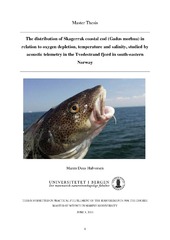The distribution of Skagerrak coastal cod (Gadus morhua) in relation to oxygen depletion, temperature and salinity, studied by acoustic telemetry in the Tvedestrand fjord in south-eastern Norway
Master thesis
Permanent lenke
http://hdl.handle.net/1956/7085Utgivelsesdato
2013-06-02Metadata
Vis full innførselSamlinger
Sammendrag
Decreased oxygen levels in coastal waters due to human activities are receiving increased attention as a potential threat to marine biodiversity and harvestable resources. Hydrographic measurements and hydroacoustic single fish detections were used to study the horizontal and vertical distribution of Atlantic cod (Gadus morhua) in relation to oxygen, temperature and salinity in the Tvedestrand fjord in south-eastern Norway. Sampling was conducted from September to November in 2012. Movement of cod was inferred from hydroacoustic single fish detections (telemetry) and related to ambient environmental conditions. Our data clearly showed that the Tvedestrand fjord experienced a long stagnation period. Oxygen concentrations decreased with depth and hypoxia occurred in the deepest water layers. Temperatures decreased with depth and stabilized at approximately 7 oC near 55 m depth. Salinity increased progressively from the surface and downwards. High-salinity water (> 34.5) was encountered close to the seafloor. Occurrence of cod was consistently highest in water depths between 2 and 14 m. The relative frequency of cod observations decreased with increasing depth and cod was nearly absent in water bodies under 35 m. Generalized additive models (GAMs) suggested that oxygen was a key parameter influencing the vertical distribution of cod in the Tvedestrand fjord, where cod generally avoided low oxygen levels. However, a small proportion of cod observations were detected in water with less than 1 mL L-1 oxygen. Cod also tended to avoid the coldest and most saline waters. Interpretation of the results from these statistical models was complicated by the fact that all three environmental variables were strongly correlated, but also somewhat aided by the fact that we had data from three different months and three fjord basins with variable hydrographic conditions. For instance, we found that there was an upward shift in the overall cod vertical distribution when the oxygen depleted layers expanded. The results presented in this thesis illustrated how movement of cod in the Tvedestrand fjord may be influenced by several hydrographical variables, including temperature and oxygen concentrations. This presents a worrying situation because cod, already challenged by intensive fishing, may lose favorable habitats and spawning sites as a result of anthropogenic influence.
